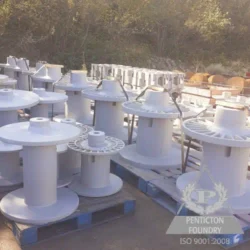Low Temperature Impact Resistant ASTM A536
on October 21, 2019Related Standards: EN-JS-1025, GGG40.3

Low temperature, impact resistant ductile iron is a spheroidal graphite cast iron similar to other ductile irons in the ASTM A536 standard such as 60-40-18. The microstructure is mainly ferritic, usually with <10% pearlite. Nodule count is an important factor when working with this low temperature, impact resistant iron. If it is too low, or too high, the impact resistance decreases and there is a risk of failure. This means that the nodule count must be optimized through chemistry and the foundry process.
EN-GJS-400-18-LT grade iron offers machinability and increased ductility, with the added advantage of improved, low temperature impact. Due to its mechanical properties and overall strength, it is frequently used as an alternative to steel castings as it decreases the weight by about 10%.
Read: To learn more about how ductile iron stacks up against steel read, “Ductile Iron Versus Steel.”
Heat Treatment and Chemistry of Low Temperature Impact Resistant Ductile Iron
This material is not recommended for heat treatment, unlike austempered ductile iron, which has a specialized heat treatment process. Low temperature, impact resistant ductile iron uses chemistry control and high-quality materials to create the desired mechanical properties.
As with almost all ductile iron standards, the chemistry is not specified, but the mechanical properties are. This means that each manufacturer is allowed to work with a chemistry that best suits their process. Below is an example of a possible chemistry.
| C | Si | Mn | P | S | Ni | Mg | |
| Low % | 3.5 | 1.95 | 0.1 | 0.01 | 0.009 | 0.08 | 0.041 |
| High % | 3.75 | 2.35 | 0.5 | 0.06 | 0.035 | 0.90 | 0.063 |
Physical and Mechanical Properties of Low Temperature Impact Resistant Ductile Iron
According to the EN-GJS-400-18-LT standard the following mechanical properties must be reached.
| Tensile Strength (mpa) | 400 |
| Yield Strength (mpa) | 240 |
| Elongation(%) | 18 |
| Minimum Impact Resistance -20 to 2C (J) | 9-12 |
Applications for Low Temperature Impact Resistant Ductile Iron
EN-GJS-400-18-LT grade iron is often used in the renewable energy industry in tidal energy and wind turbines for parts like the gear box, hub and nacelle. Some additional uses/industries include:
- Hydraulic and pneumatic industry
- Machinery and machine tools
- Oil and gas industry
- Pumps and compressors
- Cement and concrete
To learn more about ductile iron, check out our ductile iron webpage, as well as the site ductileiron.org.

